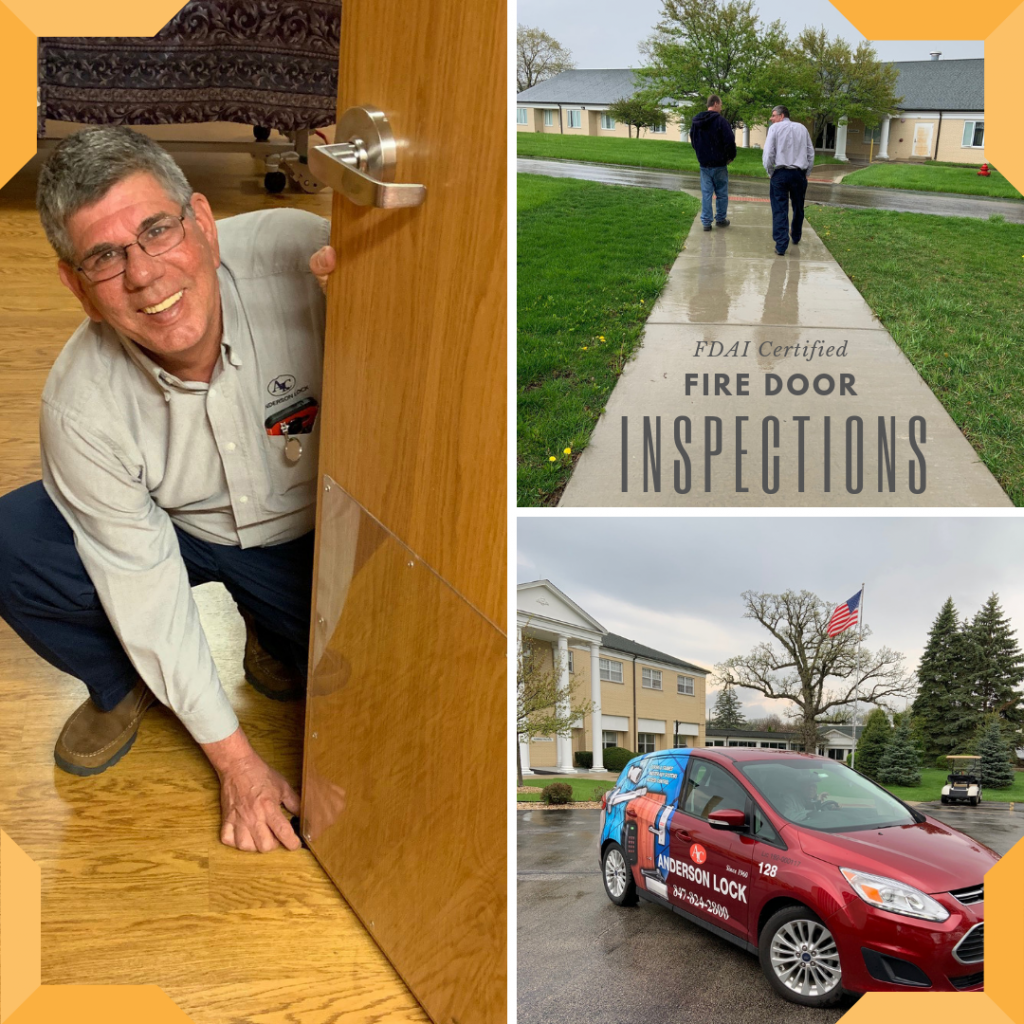
Jim Didier, a DHI certified FDAI Fire Door Inspector, measures the clearance under the bottom of a patient room door at Mount St. Joseph’s in Lake Zurich. Jim surveyed 123 doors in six buildings on the serene and spacious healthcare campus.
“Excessive gap on bottom of door.”
“Missing a screw in door closer PA bracket.”
“Plastic door armor plate.”
Jim Didier, one of Anderson Lock’s DHI Certified Fire Door Inspectors, surveyed 123 doors in 6 residential buildings at Mount Saint Joseph in Lake Zurich. He documented deficiencies, like the three examples listed above, according to the FDAI detailed checklist.
Each Fire Door Assembly Must Be Inspected Using the Following Detailed Criteria:
1. Labels are present and legible.*
2. No holes or breaks in the door or frame.
3. Glazing and glass kit / glass beads are intact and securely fastened.
4. Door, frame, and hardware are in proper working order.
5. No missing or broken parts.
6. Door clearances are within allowable limits.
7. Door closer / spring hinges are operational and the door is self-closing.
8. Coordinator ensures that door leaves close in proper sequence (pairs only).
9. Door is self-latching in the closed position.
10. Opening is not equipped with auxiliary hardware items which interfere with operation.
11. No field modifications have been performed that void the label.
12. Gasketing and edge seals, where required, are present, continuous, and of the proper type for a fire door.
13. Signage on door covers less than 5% of door face and is not attached with mechanical fasteners.*
* Items 1 and 13 on the list of inspection criteria were added in the 2013 edition of NFPA 80.
The Centers for Medicare and Medicaid Services (CMS) has adopted the 2012 edition of NFPA 101 – The Life Safety Code, which references the 2010 edition of NFPA 80. Inspections by the Joint Commission and other CMS-approved accrediting organizations are based on these publications. Therefore, health care facilities that are subject to inspections by the Joint Commission are required to provide documentation of their fire door assembly inspections.
Joint Commission Reqiures Documentation of Annual Fire Door Inspections
Jim Didier traveled to Lake Zurich on a chilly, rainy May morning because, even though all the doors in this well-maintained Intermediate Care Facility for Handicap Women latched properly, and even though all the fire and smoke doors are tied into a central system to close and latch in case of fire, there were additional criteria that need correction. Failure to properly maintain fire door assemblies violates building and fire codes, and any deficiencies noted during the inspection process must be repaired “without delay.”
Fire door inspectors provide inspection and documentation services only
Anderson Lock service techs can make any necessary repairs to ensure that building occupants are safe in case of a fire, and to keep facilities compliant with updated codes. However, fire door inspectors only provide inspection and documentation services. Any subsequent work would be scheduled separately.
Non-rated door assemblies, including corridor doors to patient care rooms and smoke barrier doors, are not subject to the annual inspection and testing requirements of either NFPA 80 or NFPA 105. However, non-rated doors should be routinely inspected as part of the facility maintenance program, and must be maintained in proper working order. When non-rated doors are removed from an FDAI Fire Door Inspection report, the number of deficiencies that “must be repaired without delay” is reduced.
It has been observed by Jim Didier, and documented in recent industry magazine articles, that there are variations in the interpretations of the CMS requirements by state inspectors. Facility managers should understand the requirements of National Fire Protection Association’s NFPA 80, Standard for Fire Doors and Other Opening Protectives, and NFPA 105, Standard for Smoke Door Assemblies and Other Opening Protectives, before they approve repairs. And, they need to be aware of the FDAI criteria, noted above, to work toward keeping non-rated doors as compliant as possible.
The ultimate purpose of a door maintenance program is to ensure people can move through buildings safely, especially in an emergency.
Contact Anderson Lock for a Fire Door Inspection
At Anderson Lock, we employ three certified fire inspectors. For this reason, we take pride in our fire door inspection knowledge. Complete this secure and easy-to-use form to schedule an appointment, or to ask more questions about fire door inspections.



